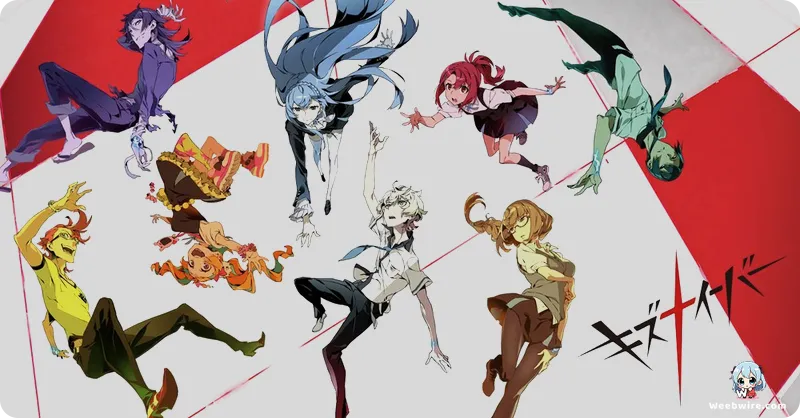Studio TRIGGER's Kiznaiver: Unveiling the Depths of Shared Pain and Empathy

In a groundbreaking departure from its signature high-octane action, Studio TRIGGER captivated audiences in 2016 with 'Kiznaiver,' an original series that masterfully delves into the profound complexities of human connection and shared emotional experience. While TRIGGER is globally lauded for visually explosive spectacles like 'Kill la Kill' and 'Promare,' 'Kiznaiver' showcased the studio's remarkable versatility, presenting a poignant, character-driven drama centered on empathy forged through collective pain. This strategic shift underscores TRIGGER's artistic courage and willingness to innovate beyond its established reputation, offering a compelling narrative that resonated deeply with viewers seeking more introspective storytelling.
The Enigmatic Kizna System
At its narrative core lies the enigmatic Kizna System, an audacious experimental project designed to unite individuals by compelling them to share physical and emotional suffering. The premise, deceptively straightforward, forces seven disparate high school students—each embodying a distinct facet of human struggle, metaphorically linked to a 'deadly sin'—into an inescapable bond: if one feels pain, all experience it. This ingenious concept was brought to vivid life by the unparalleled talent of Mari Okada, who served as both series composition and scriptwriter.
Okada, celebrated for her intensely emotional and often heart-wrenching narratives in works such as 'Anohana: The Flower We Saw That Day' and 'Toradora!', infused 'Kiznaiver' with remarkable emotional depth. Her involvement was pivotal, transforming the sci-fi mechanism into a powerful vehicle for exploring intricate interpersonal relationships rather than a mere superficial gimmick. Okada's distinctive style, which deftly navigates the tumultuous landscape of adolescent angst, unrequited affection, and the universal quest for belonging, permeates 'Kiznaiver,' making the characters' tribulations and eventual breakthroughs profoundly relatable.

Distinctive Visuals and Philosophical Depths
Adding another layer of distinction, 'Kiznaiver' boasts the unique character designs of Shirow Miwa, renowned for his work on the manga series 'Dogs: Bullets & Carnage.' Miwa's sharp, angular, and highly stylized art imbues 'Kiznaiver' with an unmistakable visual identity that sets it apart in the contemporary anime landscape. His designs subtly communicate each character's personality and inner turmoil, even before their stories fully unfold. For instance, the detached protagonist, Katsuhira Agata, is portrayed with an almost ethereal quality, contrasting sharply with the grounded, expressive appearance of the fiery Chidori Takashiro. This meticulous visual storytelling through character design is a testament to the synergistic creativity driving the production.
The philosophical underpinnings of the Kizna System offer rich intellectual fodder. The system's ostensible goal is to foster global peace by enforcing empathy; the theory being that if humanity literally felt each other's pain, conflict would cease. However, the series brilliantly deconstructs this idealism, revealing that shared suffering does not automatically guarantee harmony but can, paradoxically, amplify existing tensions and expose hidden vulnerabilities. The city of Sugomori itself, the crucible for this experiment, transcends mere backdrop; it serves as a meticulously controlled 'test tube' for the Kizna System. Its very name, 'Sugomori' (巣籠もり), evocatively translates to 'nesting' or 'holed up in a nest,' symbolizing the isolation and controlled existence of the characters under the watchful eyes of the enigmatic Noriko Sonozaki and her team. Sugomori’s seemingly utopian façade conceals a darker, experimental purpose, rendering it an active, narrative-shaping entity rather than passive scenery.
The Seven Kiznaivers and Their Journey
Furthermore, the deliberate selection of the seven Kiznaivers is steeped in symbolic meaning. Each character embodies a specific personality trait—often a 'flaw' or 'sin'—that the Kizna System ostensibly aims to 'correct' through shared pain. Katsuhira represents 'apathy,' Chidori 'self-righteousness,' Hajime Tenga 'violence,' Tsuguhito Yuta 'cunning,' Honoka Maki 'pride,' Nico Niyama 'eccentricity,' and Hisomu Yoshiharu 'immorality' or 'masochism.' The transformative journey of these characters, compelled to confront not only each other's suffering but also their own hidden truths, forms the series' emotional backbone. Their evolution from disparate individuals into a cohesive, albeit often fractious, unit powerfully illustrates the true potential of empathy, even when forcibly induced.
The Evocative Score of Yuki Hayashi
The evocative musical score by Yuki Hayashi significantly elevates 'Kiznaiver’s' emotional resonance. Hayashi, acclaimed for his dynamic compositions in hits like 'Haikyuu!!' and 'My Hero Academia,' brings a more melancholic and introspective touch to 'Kiznaiver,' perfectly complementing its dramatic themes. The soundtrack skillfully blends electronic and orchestral elements, underscoring moments of tension, despair, and ultimately, hope, subtly guiding the viewer's emotional journey alongside the characters.
While 'Kiznaiver' may not command the same widespread discussion as some of TRIGGER's more action-centric endeavors, its unique premise, profound exploration of human connection through shared pain, and the masterful contributions of talents like Mari Okada and Shirow Miwa establish it as a truly captivating and thought-provoking anime. It stands as a powerful testament to Studio TRIGGER's artistic breadth and its capacity to craft narratives that resonate deeply on both emotional and philosophical levels, proving that sometimes, the most impactful stories are those that delicately unravel the quiet intricacies of the human heart, rather than merely showcasing its explosive potential.
Credits
Kiznaiver
Author
TRIGGER, Mari Okada
Cover Art
Shirow Miwa
Studio
TRIGGER
Publisher
Kiznaiver Production Committee
Producers





